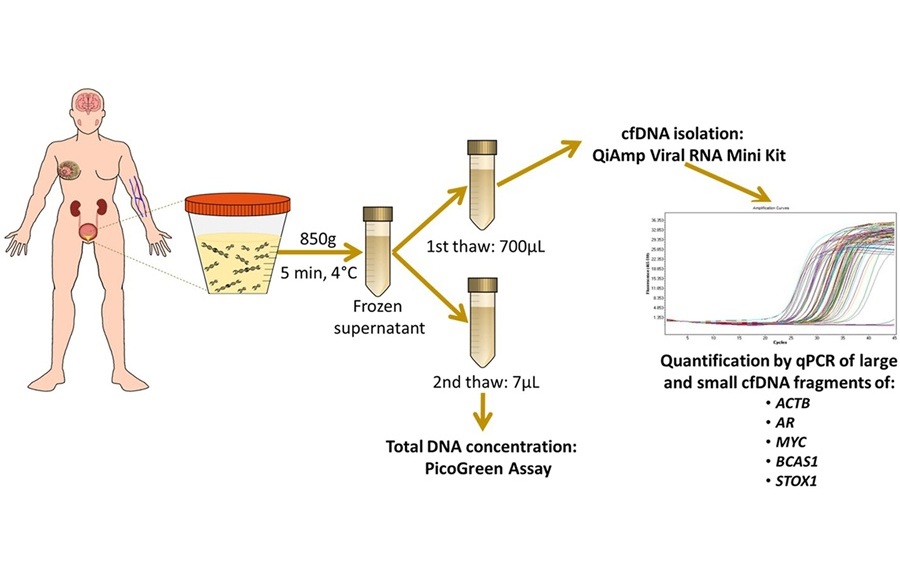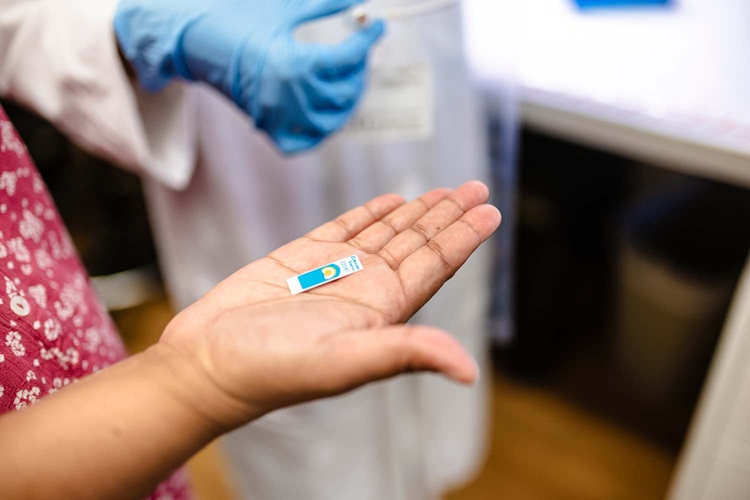Report Discusses POC Testing and Changing Paradigms
|
By LabMedica International staff writers Posted on 20 Jun 2017 |

Image: A new report suggests utilization of trained personnel and evaluation of tests will help ensure that best-quality tests are ordered and interpreted correctly to benefit patient care (Photo courtesy of the American Society for Microbiology).
The American Academy of Microbiology has released a new report on the role of the role of point-of-care (POC) and near-patient testing in changing diagnostic paradigms in microbiology.
Technology for diagnosing infectious diseases in patients is rapidly advancing, and new diagnostic tests have the potential to meaningfully improve patient care. Recommendations for the Academy’s report (Changing Diagnostic Paradigms for Microbiology, published May 2017) were based on discussions of a panel of experts. The Academy convened a colloquium October 17-18, 2016, (Washington, DC; USA) to explore the development and implementation of near-patient and POC testing and to provide recommendations for using these tests to improve patient care across clinical settings.
“Rapid diagnostic tests have the potential to deliver timely results, enable treatment decisions by detecting the presence of biomarkers, distinguish between viral and bacterial infections, identify causative organisms, and provide information on drug resistance,” said Melissa Miller, PhD, steering committee chair of the colloquium. The report focuses on the unmet needs for research and development of new diagnostic tests, for ongoing regulatory review of POC tests, and for laboratorian expertise, even in near-patient settings. The participants also discussed the importance of proper interpretation of test results, and linking test results to electronic medical records. They emphasized the need for microbiology experts to guide the development and utilization of tests and ensure proper reporting of results.
“The expertise of clinical microbiologists is essential to maximizing the value and minimizing the risk of POC infectious disease diagnostics, provided that clinical microbiologists adapt their practice to this setting,” said Sheldon Campbell, MD, PhD, Yale School of Medicine, a participant in the colloquium.
The report summarized proper utilization of tests (such as ordering appropriate tests and correctly interpreting results), the need for proper training and education on test usage, and contamination concerns. It also discussed regulation of the tests (reporting issues to FDA, CMS requirements), and the importance of documenting results and reporting to health departments when necessary. For the future, participants agreed that POC tests should be linked to web-based quality and performance matrices that would revolutionize POC testing quality and reach.
A commentary with additional information on advances in diagnostics, Advances Afoot in Microbiology by Mayo Clinic’s Patel R and Karon BS, was published May 24, 2017, in the Journal of Clinical Microbiology.
Technology for diagnosing infectious diseases in patients is rapidly advancing, and new diagnostic tests have the potential to meaningfully improve patient care. Recommendations for the Academy’s report (Changing Diagnostic Paradigms for Microbiology, published May 2017) were based on discussions of a panel of experts. The Academy convened a colloquium October 17-18, 2016, (Washington, DC; USA) to explore the development and implementation of near-patient and POC testing and to provide recommendations for using these tests to improve patient care across clinical settings.
“Rapid diagnostic tests have the potential to deliver timely results, enable treatment decisions by detecting the presence of biomarkers, distinguish between viral and bacterial infections, identify causative organisms, and provide information on drug resistance,” said Melissa Miller, PhD, steering committee chair of the colloquium. The report focuses on the unmet needs for research and development of new diagnostic tests, for ongoing regulatory review of POC tests, and for laboratorian expertise, even in near-patient settings. The participants also discussed the importance of proper interpretation of test results, and linking test results to electronic medical records. They emphasized the need for microbiology experts to guide the development and utilization of tests and ensure proper reporting of results.
“The expertise of clinical microbiologists is essential to maximizing the value and minimizing the risk of POC infectious disease diagnostics, provided that clinical microbiologists adapt their practice to this setting,” said Sheldon Campbell, MD, PhD, Yale School of Medicine, a participant in the colloquium.
The report summarized proper utilization of tests (such as ordering appropriate tests and correctly interpreting results), the need for proper training and education on test usage, and contamination concerns. It also discussed regulation of the tests (reporting issues to FDA, CMS requirements), and the importance of documenting results and reporting to health departments when necessary. For the future, participants agreed that POC tests should be linked to web-based quality and performance matrices that would revolutionize POC testing quality and reach.
A commentary with additional information on advances in diagnostics, Advances Afoot in Microbiology by Mayo Clinic’s Patel R and Karon BS, was published May 24, 2017, in the Journal of Clinical Microbiology.
Latest Microbiology News
- Blood-Based Diagnostic Method Could Identify Pediatric LRTIs
- Rapid Diagnostic Test Matches Gold Standard for Sepsis Detection
- Rapid POC Tuberculosis Test Provides Results Within 15 Minutes
- Rapid Assay Identifies Bloodstream Infection Pathogens Directly from Patient Samples
- Blood-Based Molecular Signatures to Enable Rapid EPTB Diagnosis
- 15-Minute Blood Test Diagnoses Life-Threatening Infections in Children
- High-Throughput Enteric Panels Detect Multiple GI Bacterial Infections from Single Stool Swab Sample
- Fast Noninvasive Bedside Test Uses Sugar Fingerprint to Detect Fungal Infections
- Rapid Sepsis Diagnostic Device to Enable Personalized Critical Care for ICU Patients
- Microfluidic Platform Assesses Neutrophil Function in Sepsis Patients
- New Diagnostic Method Confirms Sepsis Infections Earlier
- New Markers Could Predict Risk of Severe Chlamydia Infection
- Portable Spectroscopy Rapidly and Noninvasively Detects Bacterial Species in Vaginal Fluid
- CRISPR-Based Saliva Test Detects Tuberculosis Directly from Sputum
- Urine-Based Assay Diagnoses Common Lung Infection in Immunocompromised People
- Saliva Test Detects Implant-Related Microbial Risks
Channels
Clinical Chemistry
view channel
Chemical Imaging Probe Could Track and Treat Prostate Cancer
Prostate cancer remains a leading cause of illness and death among men, with many patients eventually developing resistance to standard hormone-blocking therapies. These drugs often lose effectiveness... Read more
Mismatch Between Two Common Kidney Function Tests Indicates Serious Health Problems
Creatinine has long been the standard for measuring kidney filtration, while cystatin C — a protein produced by all human cells — has been recommended as a complementary marker because it is influenced... Read moreMolecular Diagnostics
view channel
Ultrasensitive Method Detects Low-Frequency Cancer Mutations
Liquid biopsy has emerged as a promising approach for cancer detection and treatment monitoring, although its clinical impact has been limited by the extremely low levels of tumor-derived DNA circulating in blood.... Read more
Blood Test Enables Non-Invasive Endometriosis Detection
Endometriosis is a chronic, complex, yet relatively common gynecological disorder, reportedly affecting 1 in 10 adult and adolescent women. Endometriosis causes tissue similar to the lining of the uterus... Read moreHematology
view channel
MRD Tests Could Predict Survival in Leukemia Patients
Acute myeloid leukemia is an aggressive blood cancer that disrupts normal blood cell production and often relapses even after intensive treatment. Clinicians currently lack early, reliable markers to predict... Read more
Platelet Activity Blood Test in Middle Age Could Identify Early Alzheimer’s Risk
Early detection of Alzheimer’s disease remains one of the biggest unmet needs in neurology, particularly because the biological changes underlying the disorder begin decades before memory symptoms appear.... Read more
Microvesicles Measurement Could Detect Vascular Injury in Sickle Cell Disease Patients
Assessing disease severity in sickle cell disease (SCD) remains challenging, especially when trying to predict hemolysis, vascular injury, and risk of complications such as vaso-occlusive crises.... Read more
ADLM’s New Coagulation Testing Guidance to Improve Care for Patients on Blood Thinners
Direct oral anticoagulants (DOACs) are one of the most common types of blood thinners. Patients take them to prevent a host of complications that could arise from blood clotting, including stroke, deep... Read moreImmunology
view channel
Routine Blood Test Can Predict Who Benefits Most from CAR T-Cell Therapy
CAR T-cell therapy has transformed treatment for patients with relapsed or treatment-resistant non-Hodgkin lymphoma, but many patients eventually relapse despite an initial response. Clinicians currently... Read more
New Test Distinguishes Vaccine-Induced False Positives from Active HIV Infection
Since HIV was identified in 1983, more than 91 million people have contracted the virus, and over 44 million have died from related causes. Today, nearly 40 million individuals worldwide live with HIV-1,... Read more
Gene Signature Test Predicts Response to Key Breast Cancer Treatment
DK4/6 inhibitors paired with hormone therapy have become a cornerstone treatment for advanced HR+/HER2– breast cancer, slowing tumor growth by blocking key proteins that drive cell division.... Read more
Chip Captures Cancer Cells from Blood to Help Select Right Breast Cancer Treatment
Ductal carcinoma in situ (DCIS) accounts for about a quarter of all breast cancer cases and generally carries a good prognosis. This non-invasive form of the disease may or may not become life-threatening.... Read morePathology
view channel
Rapid Low-Cost Tests Can Prevent Child Deaths from Contaminated Medicinal Syrups
Medicinal syrups contaminated with toxic chemicals have caused the deaths of hundreds of children worldwide, exposing a critical gap in how these products are tested before reaching patients.... Read more
Tumor Signals in Saliva and Blood Enable Non-Invasive Monitoring of Head and Neck Cancer
Head and neck cancers are among the most aggressive malignancies worldwide, with nearly 900,000 new cases diagnosed each year. Monitoring these cancers for recurrence or relapse typically relies on tissue... Read more
Common Health Issues Can Influence New Blood Tests for Alzheimer’s Disease
Blood-based tests for Alzheimer’s disease are transforming diagnosis by offering a simpler alternative to spinal taps and brain imaging. However, many people evaluated at memory clinics also live with... Read more
Blood Test Formula Identifies Chronic Liver Disease Patients with Higher Cancer Risk
Chronic liver disease affects millions worldwide and can progress silently to hepatocellular carcinoma (HCC), one of the deadliest cancers globally. While surveillance guidelines exist for patients with... Read moreTechnology
view channel
Artificial Intelligence Model Could Accelerate Rare Disease Diagnosis
Identifying which genetic variants actually cause disease remains one of the biggest challenges in genomic medicine. Each person carries tens of thousands of DNA changes, yet only a few meaningfully alter... Read more
AI Saliva Sensor Enables Early Detection of Head and Neck Cancer
Early detection of head and neck cancer remains difficult because the disease produces few or no symptoms in its earliest stages, and lesions often lie deep within the head or neck, where biopsy or endoscopy... Read moreIndustry
view channel
Abbott Acquires Cancer-Screening Company Exact Sciences
Abbott (Abbott Park, IL, USA) has entered into a definitive agreement to acquire Exact Sciences (Madison, WI, USA), enabling it to enter and lead in fast-growing cancer diagnostics segments.... Read more




 assay.jpg)














